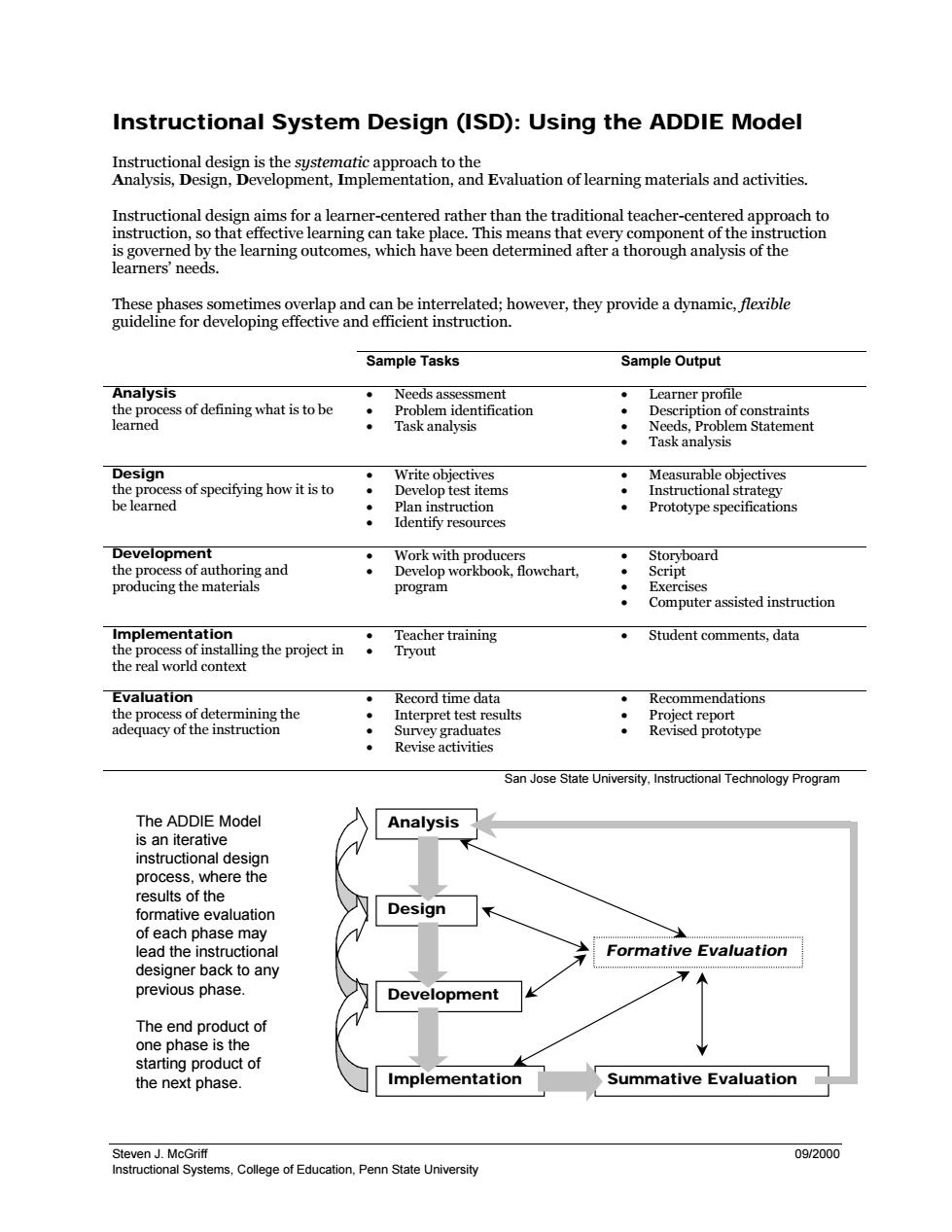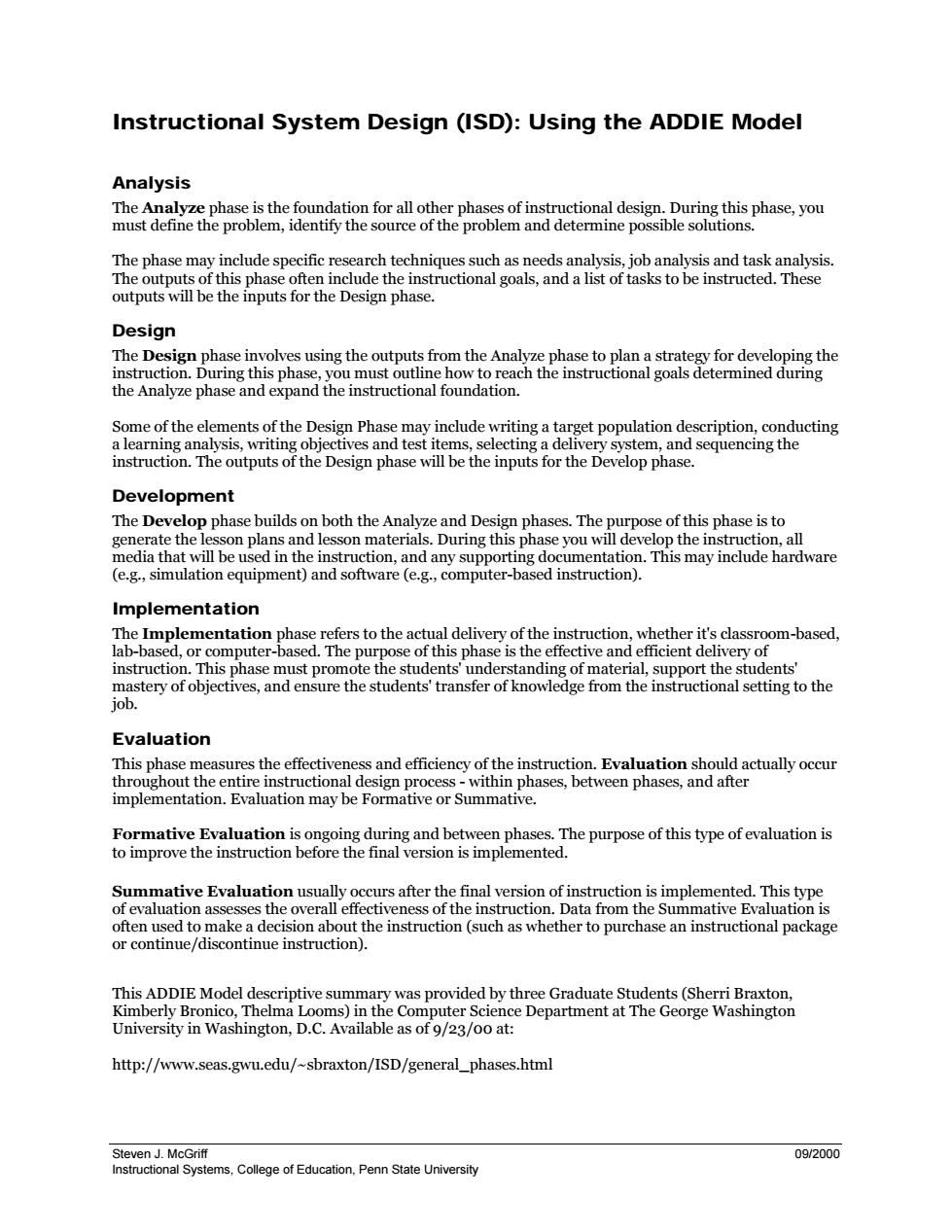
Instructional System Design(ISD):Using the ADDIE Model ional design is the su Analysis,Design,Development,Implementation,and Evaluation of learning materials and activities. s for a le h to Sample Tasks Sample Output ess of defining what is to be Task analysis Design Write obiecti Measurable c s of specifying how it is to Develop test items pntoctional identify resources Developmen Storyboard the program : Computer as ssisted instruction ortang Student comments,data · equacy of the ins : Revised prototype San Jose State University.Instructional Technology Prograr The ADDIE Model Analysis is an iterative instructional design where the valuatior Design of each phase may lead the instructional Formative Evaluation Development The end product of one phase is the ct o Implementation Summative Evaluation Steven J.McGriff 092000 ional Systems,Collegeof Edu cation,Penn State University
Steven J. McGriff 09/2000 Instructional Systems, College of Education, Penn State University Instructional System Design (ISD): Using the ADDIE Model Instructional design is the systematic approach to the Analysis, Design, Development, Implementation, and Evaluation of learning materials and activities. Instructional design aims for a learner-centered rather than the traditional teacher-centered approach to instruction, so that effective learning can take place. This means that every component of the instruction is governed by the learning outcomes, which have been determined after a thorough analysis of the learners’ needs. These phases sometimes overlap and can be interrelated; however, they provide a dynamic, flexible guideline for developing effective and efficient instruction. Sample Tasks Sample Output Analysis the process of defining what is to be learned · Needs assessment · Problem identification · Task analysis · Learner profile · Description of constraints · Needs, Problem Statement · Task analysis Design the process of specifying how it is to be learned · Write objectives · Develop test items · Plan instruction · Identify resources · Measurable objectives · Instructional strategy · Prototype specifications Development the process of authoring and producing the materials · Work with producers · Develop workbook, flowchart, program · Storyboard · Script · Exercises · Computer assisted instruction Implementation the process of installing the project in the real world context · Teacher training · Tryout · Student comments, data Evaluation the process of determining the adequacy of the instruction · Record time data · Interpret test results · Survey graduates · Revise activities · Recommendations · Project report · Revised prototype San Jose State University, Instructional Technology Program Analysis Design Development Implementation Summative Evaluation Formative Evaluation The ADDIE Model is an iterative instructional design process, where the results of the formative evaluation of each phase may lead the instructional designer back to any previous phase. The end product of one phase is the starting product of the next phase

Instructional System Design(ISD):Using the ADDIE Model Analysis The phase may include specific research techniques such as needs analysis,job analysis and task analysis. b the inputs for the Design phasercon nd ass tobe nsucted.mhese Design The Design phase involves using the outputs from the Analyze phase to plan a strategy for developing the ring th Some of the eler ents of the sign Phas may include egpoationkeeptionomdctng will be the inputs fo the sequencing th Development The Develop phase builds on both the Analyze and Design phases.The urpose of this phase is to During th ase you wi dwar (e.g.,simulation equipment)and software (e.g.computer-based instruction). Implementation instruction.This phase must promote the students understanding of material,sup oport the students' mo apalMouy jo ajsuen squapnis am amsua pue Evaluation This phase measures the effectiven s and efficiency of the instruction.Evaluation should actually occur een phases.The purpose of this type of evaluation is native evalu tion u s after the final version of instruction is implemented.This tyn of evaluation ass sses the overall effectiveness of the instruction.Data from the Summative Evaluation is instruc This ADDIE Model descriptive summary was provided by three Graduate Students(Sherri Braxton, 9/23/00 http://www.seas.gwu.edu/-sbraxton/ISD/general_phases.html 09/2000
Steven J. McGriff 09/2000 Instructional Systems, College of Education, Penn State University Instructional System Design (ISD): Using the ADDIE Model Analysis The Analyze phase is the foundation for all other phases of instructional design. During this phase, you must define the problem, identify the source of the problem and determine possible solutions. The phase may include specific research techniques such as needs analysis, job analysis and task analysis. The outputs of this phase often include the instructional goals, and a list of tasks to be instructed. These outputs will be the inputs for the Design phase. Design The Design phase involves using the outputs from the Analyze phase to plan a strategy for developing the instruction. During this phase, you must outline how to reach the instructional goals determined during the Analyze phase and expand the instructional foundation. Some of the elements of the Design Phase may include writing a target population description, conducting a learning analysis, writing objectives and test items, selecting a delivery system, and sequencing the instruction. The outputs of the Design phase will be the inputs for the Develop phase. Development The Develop phase builds on both the Analyze and Design phases. The purpose of this phase is to generate the lesson plans and lesson materials. During this phase you will develop the instruction, all media that will be used in the instruction, and any supporting documentation. This may include hardware (e.g., simulation equipment) and software (e.g., computer-based instruction). Implementation The Implementation phase refers to the actual delivery of the instruction, whether it's classroom-based, lab-based, or computer-based. The purpose of this phase is the effective and efficient delivery of instruction. This phase must promote the students' understanding of material, support the students' mastery of objectives, and ensure the students' transfer of knowledge from the instructional setting to the job. Evaluation This phase measures the effectiveness and efficiency of the instruction. Evaluation should actually occur throughout the entire instructional design process - within phases, between phases, and after implementation. Evaluation may be Formative or Summative. Formative Evaluation is ongoing during and between phases. The purpose of this type of evaluation is to improve the instruction before the final version is implemented. Summative Evaluation usually occurs after the final version of instruction is implemented. This type of evaluation assesses the overall effectiveness of the instruction. Data from the Summative Evaluation is often used to make a decision about the instruction (such as whether to purchase an instructional package or continue/discontinue instruction). This ADDIE Model descriptive summary was provided by three Graduate Students (Sherri Braxton, Kimberly Bronico, Thelma Looms) in the Computer Science Department at The George Washington University in Washington, D.C. Available as of 9/23/00 at: http://www.seas.gwu.edu/~sbraxton/ISD/general_phases.html